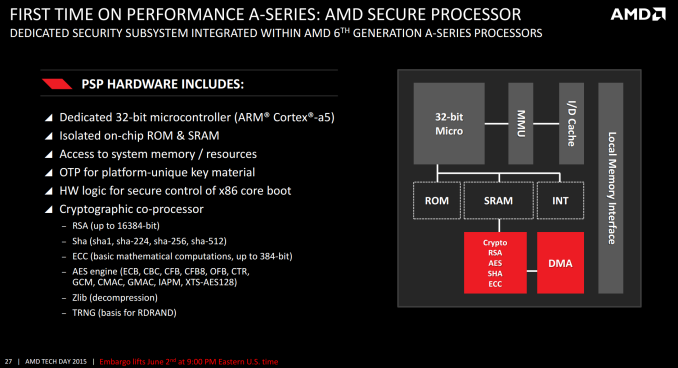AMD Launches Carrizo: The Laptop Leap of Efficiency and Architecture Updates
by Ian Cutress on June 2, 2015 9:00 PM ESTAMD Secure Processor
One of the final pieces in the puzzle is AMD’s Secure Processor, which they seemed to have called the PSP. The concept of the security processor has evolved over time, but the premise of a locked down area to perform sensitive work that is both hidden and cryptographically sealed appeals to a particular element of the population, particularly when it comes to business.
AMD’s PSP is based around a single 32-bit ARM Cortex-A5, with its own isolated ROM and SRAM but has access to system memory and resources. It contains logic to deal with the x86 POST process but also features a cryptographic co-processor.
ARM has been promoting TrustZone for a couple of years now, and AMD has been tinkering with their Secure Processor proposition for almost as long although relatively few explanations from AMD outside ‘it is there’ have come forward.
Final Thoughts
Sometimes a name can inspire change. Carrizo isn’t one of those names, and when hearing the words ‘AMD’s notebook processor’, those words have not instilled much hope in the past, much to AMD’s chagrin no doubt. Despite this, we come away from Carrizo with a significantly positive impression because this feels more than just another Bulldozer-based update.
If you can say in a sentence ‘more performance, less power and less die area’, it almost sounds like a holy trifecta of goals a processor designer can only hope to accomplish. Normally a processor engineer is all about performance, so it takes an adjustment in thinking to focus more so on power, but AMD is promising this with Carrizo. Part of this will be down to the effectiveness of the high density libraries (which according to the slides should also mean less power or more performance for less die area) but also the implementation of the higher bandwidth encoder, new video playback pathway and optimization of power through the frequency planes. Doubling the L1 data cache for no loss in latency will have definite impacts to IPC, as well as the better prefetch and branch prediction.
Technically, on paper, all the blocks in play look exciting and every little margin can help AMD build a better APU. It merely requires validation of the results we have been presented along with a killer device to go along with it, something which AMD has lacked in the past and reviewers have had trouble getting their hands on. We are in discussions with AMD to get the sufficient tools to test independently a number of the claims, and to see if AMD’s Carrizo has potential.











137 Comments
View All Comments
AS118 - Saturday, June 6, 2015 - link
I already signed up on the mailing list that tells you when Laptops with Carrizo come out and are ready to buy. You can do so on AMD's website if you're interested. The H.265 hardware decoding alone interests me, and all the other features like program-specific acceleration and the better GPU performance for mainstream games is nice.If you only play stuff like LoL or Counterstrike, or browser games or even older games on GoG and Steam, the A10 and up look like they'll be quite good.
ivyanev - Sunday, June 7, 2015 - link
As the performance is more than enough for everyday use, and the price is good, using it in mini PC would be great.watzupken - Thursday, June 11, 2015 - link
I was thinking the same thing. If they can produce this for use in those NUC sized PC, I will consider getting one as HTPC if the price is right.Fujikoma - Sunday, June 7, 2015 - link
AMD not including VP9 support is a mistake. They could always drop it if YouTube isn't as popular, but a lot of video in media articles tends to be linked to YouTube.It would be nice to see a die shrink with AMD adding more CPU cores to make up the difference to at least compete with Intel in number crunching.
ivyanev - Tuesday, June 9, 2015 - link
Try using h264ify plugin for chrome - it disables the vp8 and vp9 video, and youtube plays the mp4 versions - butter smooth and efficientfigus77 - Thursday, June 11, 2015 - link
I think everyone should look at APU with respect, apu is the future of pc and notebook, HBM on next AMD GPU will be a start and test for new APU with HBM on chip ram, that will be faster and faster than any ddr4 now available in market and probably any 'on motherboard' ram we will ever see, AMD could start a revolution in PC market, and other will probably copy them in short, even with faster cpu, but IF that will happens we shall be grate to AMD.And sorry for my english...
JDub8 - Tuesday, June 16, 2015 - link
Something I'm always interested in but is never addressed in these articles. The UVD playback and all its magical power savings - what codecs/players support it? If I have a CCCP installed will MPC-HC automaticall benifit? Or will that be reserved for some cyberpower payware dvd/bd player?